Thermal Comfort in the Passenger Compartment Using a 3-D Numerical Analysis and Comparison with Fanger’s Comfort Models
Abstract
1. Introduction
2. Materials and Methods
2.1. Governing Equations and Numerical Details
2.2. Passenger Compartment Model
2.3. Thermal Comfort Models
- (a)
- The air in the car cabin is ideal and incompressible.
- (b)
- The concentration of organic compounds and CO2 that affect cabin air quality are neglected.
- (c)
- The intensity of turbulent flows in the cabin is low.
- (d)
- Only sensible heat dissipated by the human body with even distribution is considered.
3. Results and Discussion
4. Conclusions
- Thermal sensation inside a passenger car was assessed using a general thermal comfort index. The general thermal comfort index is a new method to link the available thermal comfort models, which helps to predict how close we are to target conditions for cabin thermal comfort.
- 3D numerical simulations with solar radiation effects showed inhomogeneous airflow distribution particularly for the early 1200 seconds of the cooling down period but a steady-state distribution for velocity and temperature was observed afterward. Console temperature decreased very slowly because of solar radiation acting directly.
- The conventional ventilation scheme study revealed that the airflow generated from the center and side air-conditioning vents were strongly deflected near the driver’s body resulting in complex motion with high flow mixing. The velocity of air is a key parameter influencing airflow patterns.
- The computed index revealed that although the equivalent temperature model surpassed the other models, because of the homogenous assumption limit in later, Fanger’s model and modified Fanger’s model provided satisfactory results in terms of thermal comfort index. However, the modified Fanger’s model was 12% more sensitive when evaluated using general thermal comfort index.
Author Contributions
Funding
Conflicts of Interest
Nomenclature
| Fp-j | View factor between the person and surface j |
| Relative pressure loss | |
| fcl | Clothing surface area factor |
| hc | Convective heat transfer coefficient (W/m2K) |
| Icl | Clothing insulation (m2K/W) |
| M | Metabolic rate (W/m2) |
| Water vapor partial pressure (Pa) | |
| Temperature [K] | |
| ta | Air temperature (°C) |
| tj | Surface temperature of immediate surface j |
| tcl | Clothing surface temperature (°C) |
| tr | Mean radiant temperature (°C) |
| va | Relative air velocity (m/s) |
| W | Effective mechanical power (W/m2) |
| Split mass fraction | |
| Abbreviations | |
| DTS | Dynamic thermal sensation |
| GCC | General car cabin |
| GGI | General grid interface |
| GID | Grid Independence |
| GTCI | General thermal comfort index |
| PMV | Predicted mean vote |
| PPD | Predicted percentage dissatisfaction |
| RH | Relative Humidity |
| S2S | Surface to surface |
| VTC | Vehicular thermal comfort |
References
- Pawar, S.; Gade, U.R.; Dixit, A.; Tadigadapa, S.B.; Jaybhay, S. Evaluation of Cabin Comfort in Air Conditioned Buses Using CFD. SAE Tech. Pap. 2014. [Google Scholar] [CrossRef]
- Koelblen, B.; Psikuta, A.; Bogdan, A.; Annaheim, S.; Rossi, R. Thermal sensation models: Validation and sensitivity towards thermo-physiological parameters. Build. Environ. 2018, 130, 200–211. [Google Scholar] [CrossRef]
- Lee, J.W.; Jang, E.Y.; Lee, S.H.; Ryou, H.S.; Choi, S.; Kim, Y. Influence of the spectral solar radiation on the air flow and temperature distributions in a passenger compartment. Int. J. Therm. Sci. 2014, 75, 36–44. [Google Scholar] [CrossRef]
- Adhikari, V.P.; Nassar, A.; Nagpurwala, Q.H. Numerical studies on the effect of cooling vent setting and solar radiation on air flow and temperature distribution in a Passenger car. SAE Tech. Pap. 2009. [Google Scholar] [CrossRef]
- Haldane, J.S. The influence of high air temperature. J. Hyg. 1905, 5, 494–513. [Google Scholar]
- Fanger, P. Thermal Comfort-Analysis and Applications in Environmental Engineering. In Thermal Comfort-Analysis and Applications in Environmental Engineering; Danish Technical Press: Copenhagen, Denmark, 1970. [Google Scholar]
- ASHRAE. ASHRAE Standard 55–2013 Thermal Environmental Conditions for Human Occupancy; ASHRAE: Atlanta, GA, USA, 2013. [Google Scholar]
- Jung, H.S.; Grady, M.L.; Victoroff, T.; Miller, A.L. Simultaneously reducing CO2 and particulate exposures via fractional recirculation of vehicle cabin air. Atmos. Environ. 2017, 160, 77–88. [Google Scholar] [CrossRef]
- Fojtlín, M.; Fišer, J.; Pokorný, J.; Povalač, A.; Urbanec, T.; Jícha, M. An innovative HVAC control system: Implementation and testing in a vehicular cabin. J. Therm. Biol. 2017, 70, 64–68. [Google Scholar] [CrossRef]
- Zhang, B.; Xue, T.; Hu, N. Analysis and improvement of the comfort performance of a car’s indoor environment based on the predicted mean vote-predicted percentage of dissatisfied and air age. Adv. Mech. Eng. 2017, 9. [Google Scholar] [CrossRef]
- Alahmer, A.; Omar, M.; Mayyas, A.R.; Qattawi, A. Analysis of vehicular cabins’ thermal sensation and comfort state, under relative humidity and temperature control, using Berkeley and Fanger models. Build. Environ. 2012, 48, 146–163. [Google Scholar] [CrossRef]
- Fišer, J.; Jícha, M. Impact of air distribution system on quality of ventilation in small aircraft cabin. Build. Environ. 2013, 69, 171–182. [Google Scholar] [CrossRef]
- Suárez, C.; Iranzo, A.; Salva, J.A.; Tapia, E.; Barea, G.; Guerra, J. Parametric investigation using computational fluid dynamics of the HVAC air distribution in a railway vehicle for representative weather and operating conditions. Energies 2017, 10, 1074. [Google Scholar] [CrossRef]
- Sevilgen, G.; Kilic, M. Investigation of transient cooling of an automobile cabin with a virtual manikin under solar radiation. Therm. Sci. 2013, 17, 397–406. [Google Scholar] [CrossRef]
- Fujita, A.; Kanemaru, J.I.; Nakagawa, H.; Ozeki, Y. Numerical simulation method to predict the thermal environment inside a car cabin. JSAE Rev. 2001, 22, 39–47. [Google Scholar] [CrossRef]
- Alahmer, A.; Mayyas, A.; Mayyas, A.A.; Omar, M.A.; Shan, D. Vehicular thermal comfort models; A comprehensive review. Appl. Therm. Eng. 2011, 31, 995–1002. [Google Scholar] [CrossRef]
- Farrington, R.B.; Rugh, J.P.; Barber, G.D. Effect of Solar-Reflective Glazing on Fuel Economy, Tailpipe Emissions, and Thermal Comfort. SAE Trans. 2000, 109, 2329–2336. [Google Scholar]
- Simion, M.; Socaciu, L.; Unguresan, P. Factors which Influence the Thermal Comfort Inside of Vehicles. Energy Procedia 2016, 85, 472–480. [Google Scholar] [CrossRef]
- Danca, P.; Bode, F.; Nastase, I.; Meslem, A. On the Possibility of CFD Modeling of the Indoor Environment in a Vehicle. Energy Procedia 2017, 112, 656–663. [Google Scholar] [CrossRef]
- Currle, J.; Maué, J. Numerical Study of the Influence of Air Vent Area and Air Mass Flux on the Thermal Comfort of Car Occupants. SAE Tech. Pap. 2000. [Google Scholar] [CrossRef]
- Al-Kayiem, H.H.; Sidik, M.F.B.M.; Munusammy, Y.R.A.L. Study on the thermal accumulation and distribution inside a parked car cabin. Am. J. Appl. Sci. 2010, 7, 784–789. [Google Scholar] [CrossRef]
- Zhang, H.; Dai, L.; Xu, G.; Li, Y.; Chen, W.; Tao, W.Q. Studies of air-flow and temperature fields inside a passenger compartment for improving thermal comfort and saving energy. Part I: Test/numerical model and validation. Appl. Therm. Eng. 2009, 29, 2022–2027. [Google Scholar] [CrossRef]
- Kaushik, S.; Chen, K.; Han, T.; Khalighi, B. Micro-Cooling/Heating Strategy for Energy Efficient HVAC System. SAE Int. J. Mater. Manuf. 2011, 4, 853–863. [Google Scholar] [CrossRef]
- Alahmer, A.; Omar, M.A.; Mayyas, A.; Dongri, S. Effect of relative humidity and temperature control on in-cabin thermal comfort state: Thermodynamic and psychometric analyses. Appl. Therm. Eng. 2011, 31, 2636–2644. [Google Scholar] [CrossRef]
- Doherty, T.; Arens, E.A. Evaluation of the physiological bases of thermal comfort models. ASHRAE Trans. 1988, 94, 1371–1385. [Google Scholar]
- Kaynakli, O.; Unver, U.; Kilic, M. Evaluating thermal environments for sitting and standing posture. Int. Commun. Heat Mass Transf. 2003, 30, 1179–1188. [Google Scholar] [CrossRef]
- Mcguffin, R.; Burke, R.; Huizenga, C.; Hui, Z.; Vlahinos, A.; Fu, G. Human Thermal Comfort Model and Manikin. SAE Tech. Pap. 2002. [Google Scholar] [CrossRef]
- ISO. ISO 7730: Ergonomics of the Thermal Environment Analytical Determination and Interpretation of Thermal Comfort Using Calculation of the PMV and PPD Indices and Local Thermal Comfort Criteria; International Standard Organization: Geneva, Switzerland, 2005. [Google Scholar]
- ISO. ISO14505–2. Ergonomics of the Thermal Environment—Evaluation of Thermal Environments in Vehicles—Part 2: Determination of Equivalent Temperature; Internationa Standard Organization: Geneva, Switzerland, 2006. [Google Scholar]
- Gilani, S.; Khan, M.H.; Ali, M. Revisiting Fanger’s thermal comfort model using mean blood pressure as a bio-marker: An experimental investigation. Appl. Therm. Eng. 2016, 109, 35–43. [Google Scholar] [CrossRef]
- Ferreira, M.S.; Yanagihara, J.I. A heat transfer model of the human upper limbs. Int. Commun. Heat Mass Transf. 2012, 39, 196–203. [Google Scholar] [CrossRef]
- Neacşu, C.A. Contributions to the Car Cockpit Thermal Comfort Optimization Using Numerical Simulation. Ph.D. Thesis, University of Pitesti, Pitești, Romania, 2011. [Google Scholar]
- Neacşu, C.A.; Ivanescu, M. The Development of a New Thermal Comfort Indexes. In Proceedings of the European Automotive Congress EAEC-ESFA 2015, Bucharest, Romania, 25–27 November 2015; Springer International Publishing: Cham, Switzerland, 2016; pp. 703–714. [Google Scholar]
- ANSYS. ANSYS Fluent User Guide; release 16.0; Ansys Inc.: Canonsburg, PA, USA, 2015. [Google Scholar]
- Moon, J.H.; Lee, J.W.; Jeong, C.H.; Lee, S.H. Thermal comfort analysis in a passenger compartment considering the solar radiation effect. Int. J. Therm. Sci. 2016, 107, 77–88. [Google Scholar] [CrossRef]
- Khatoon, S.; Kim, M.-H. Human Thermal Comfort and Heat Removal Efficiency for Ventilation Variants in Passenger Cars. Energies 2017, 10, 1710. [Google Scholar] [CrossRef]
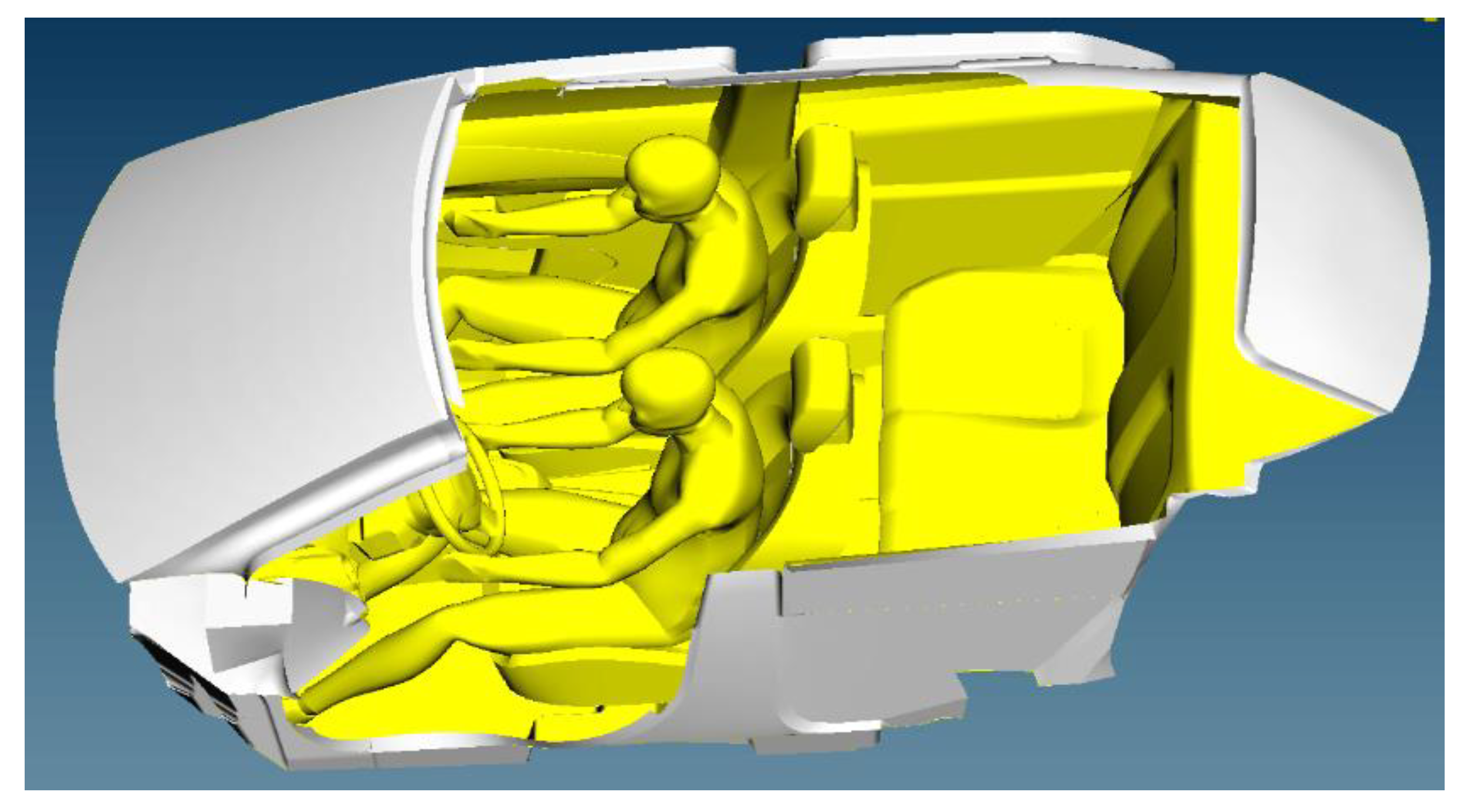
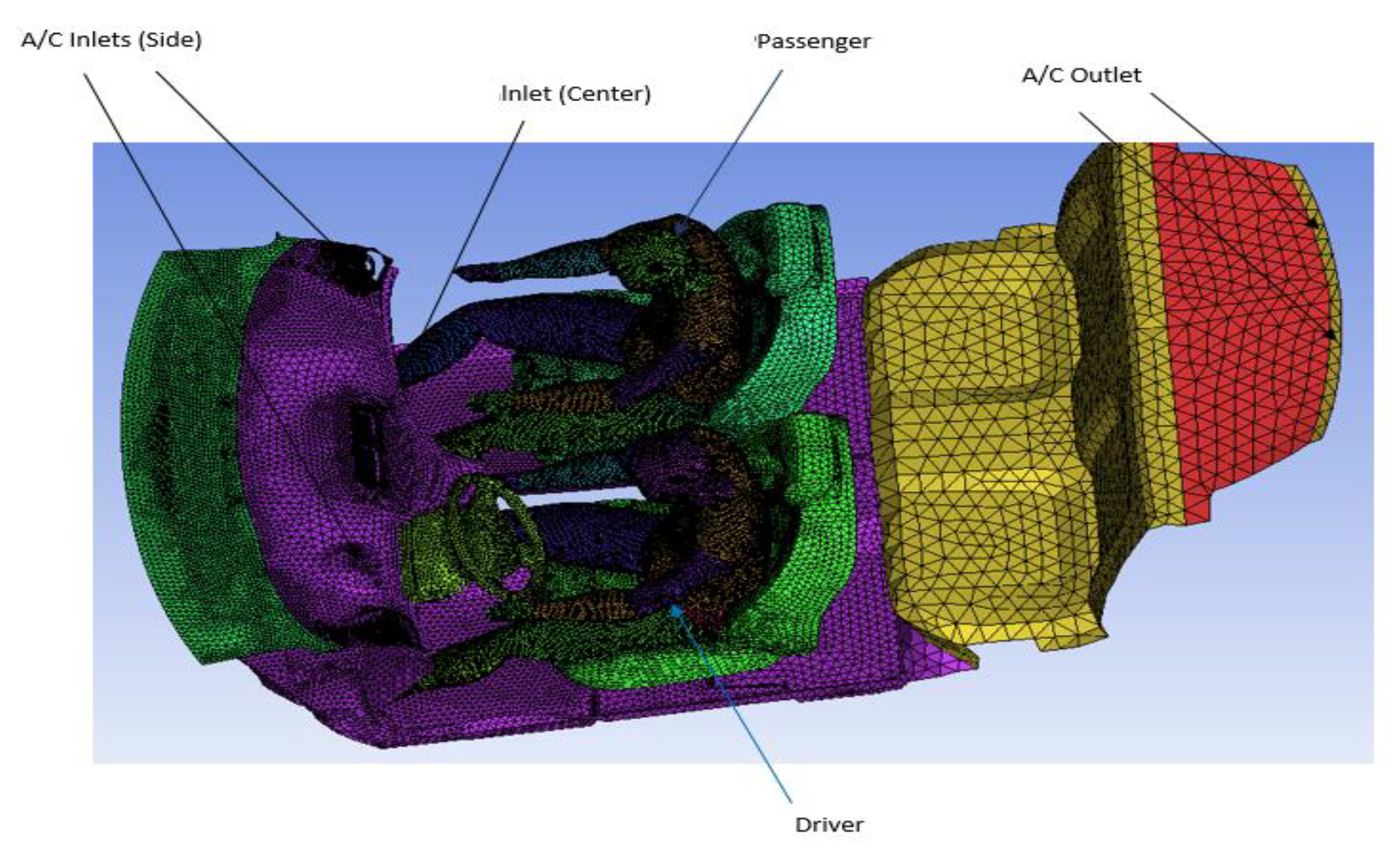
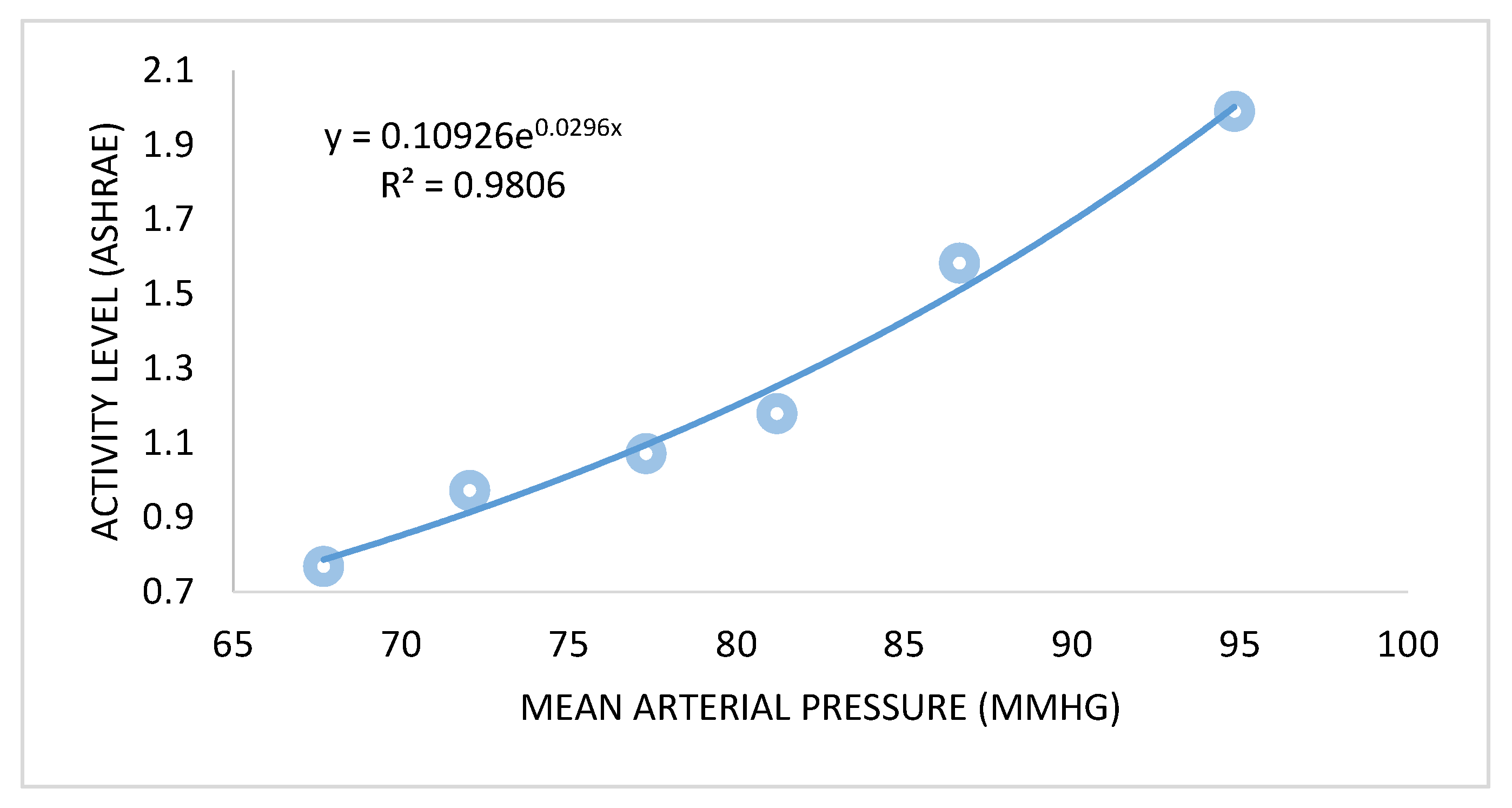
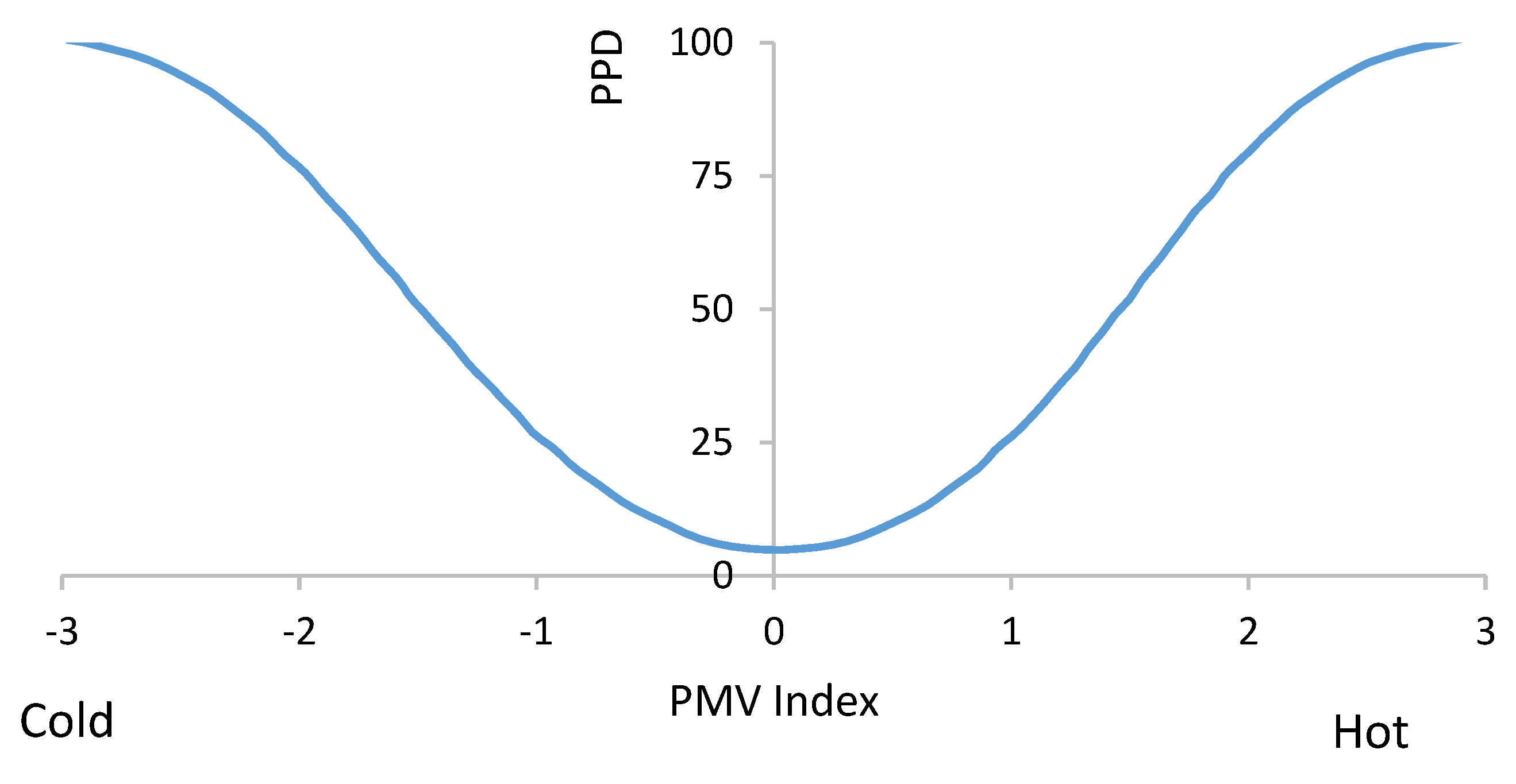

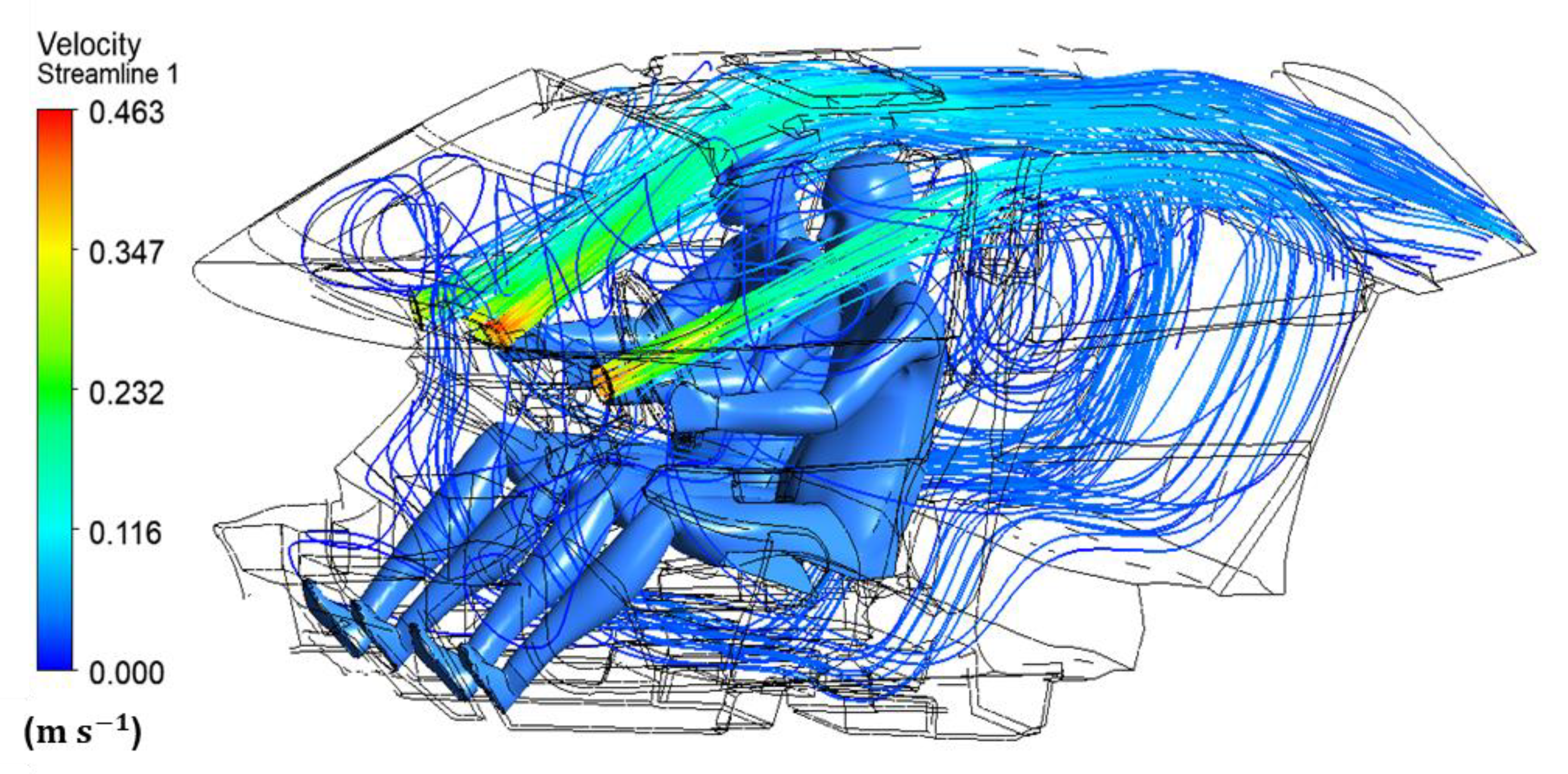
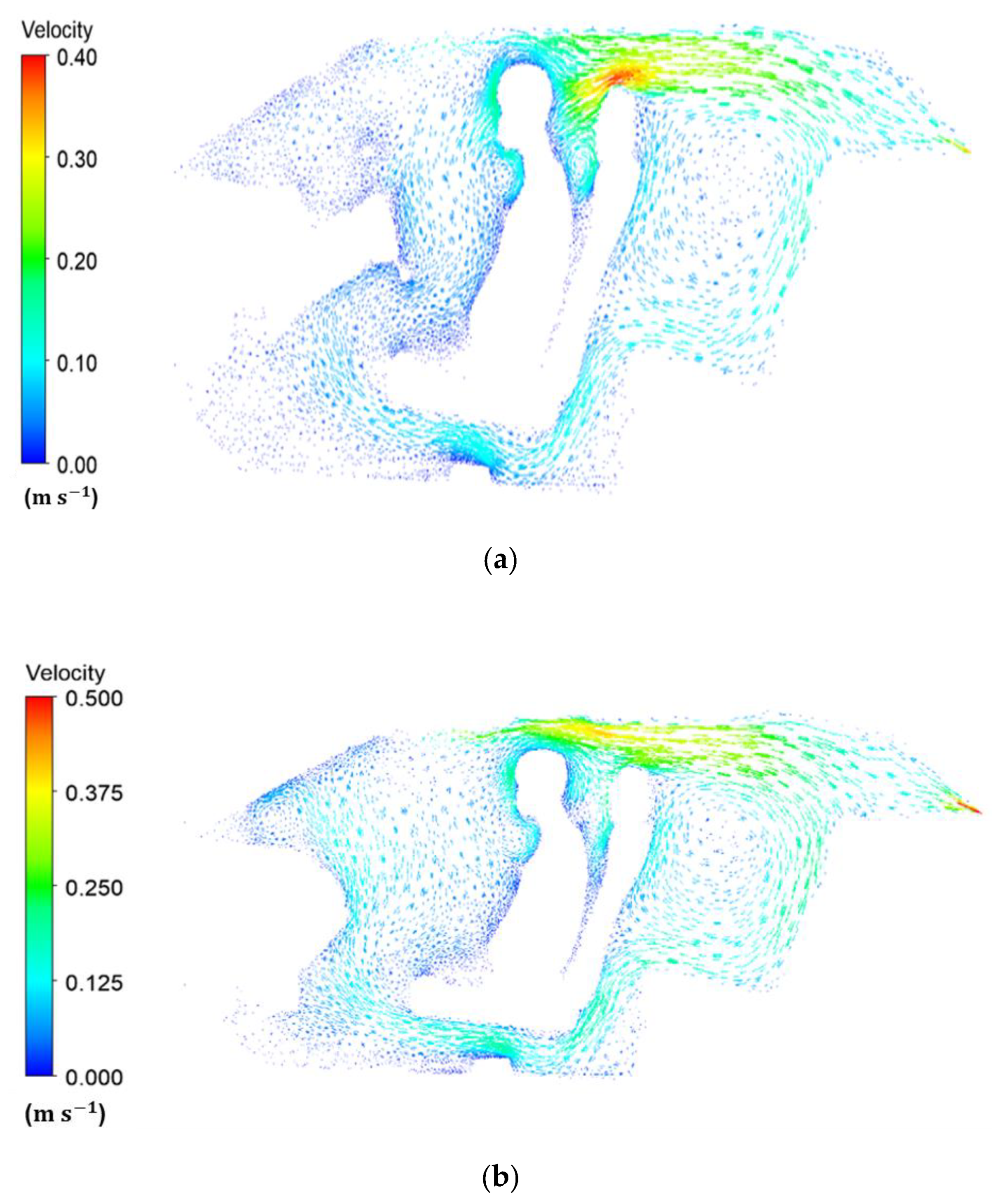

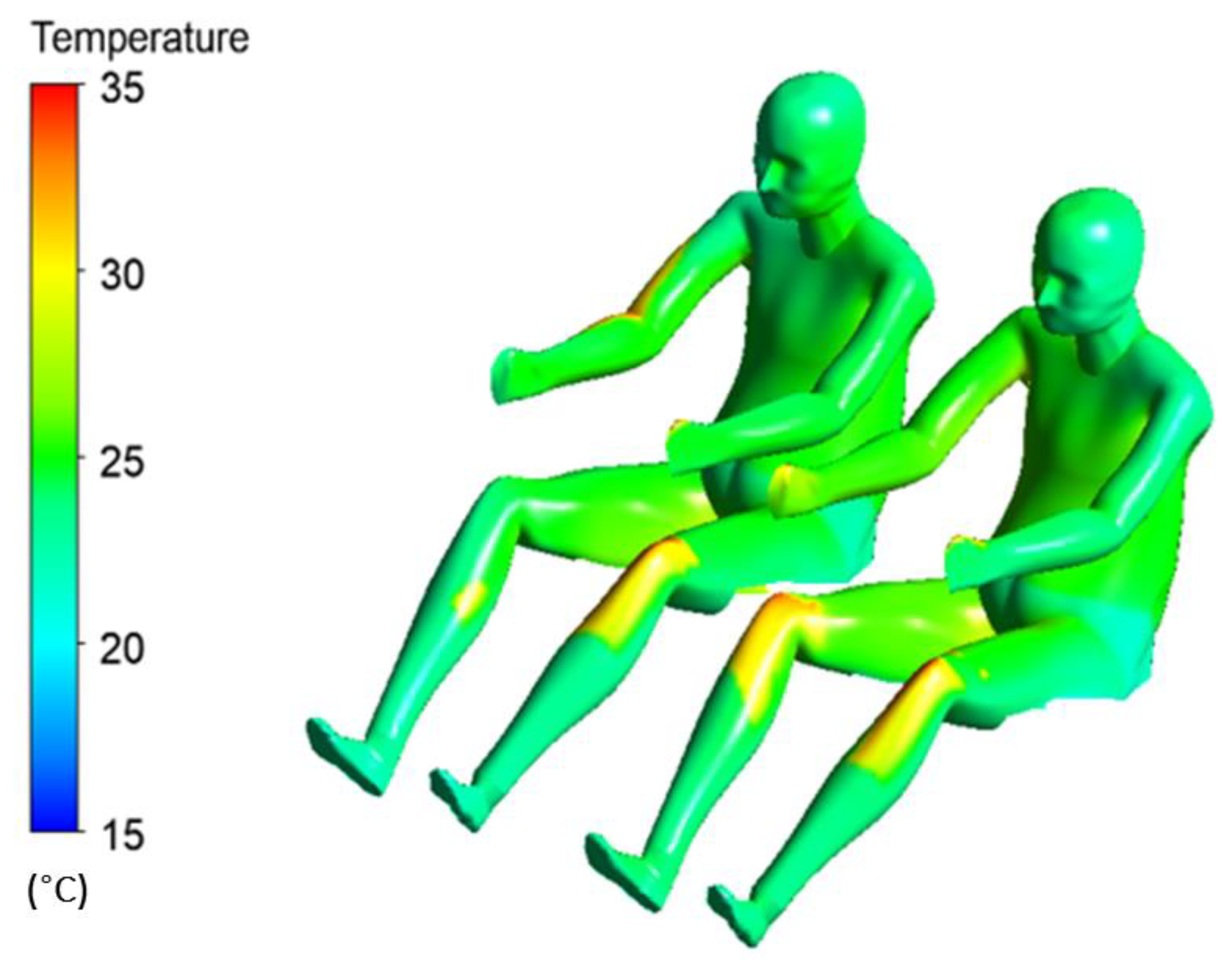
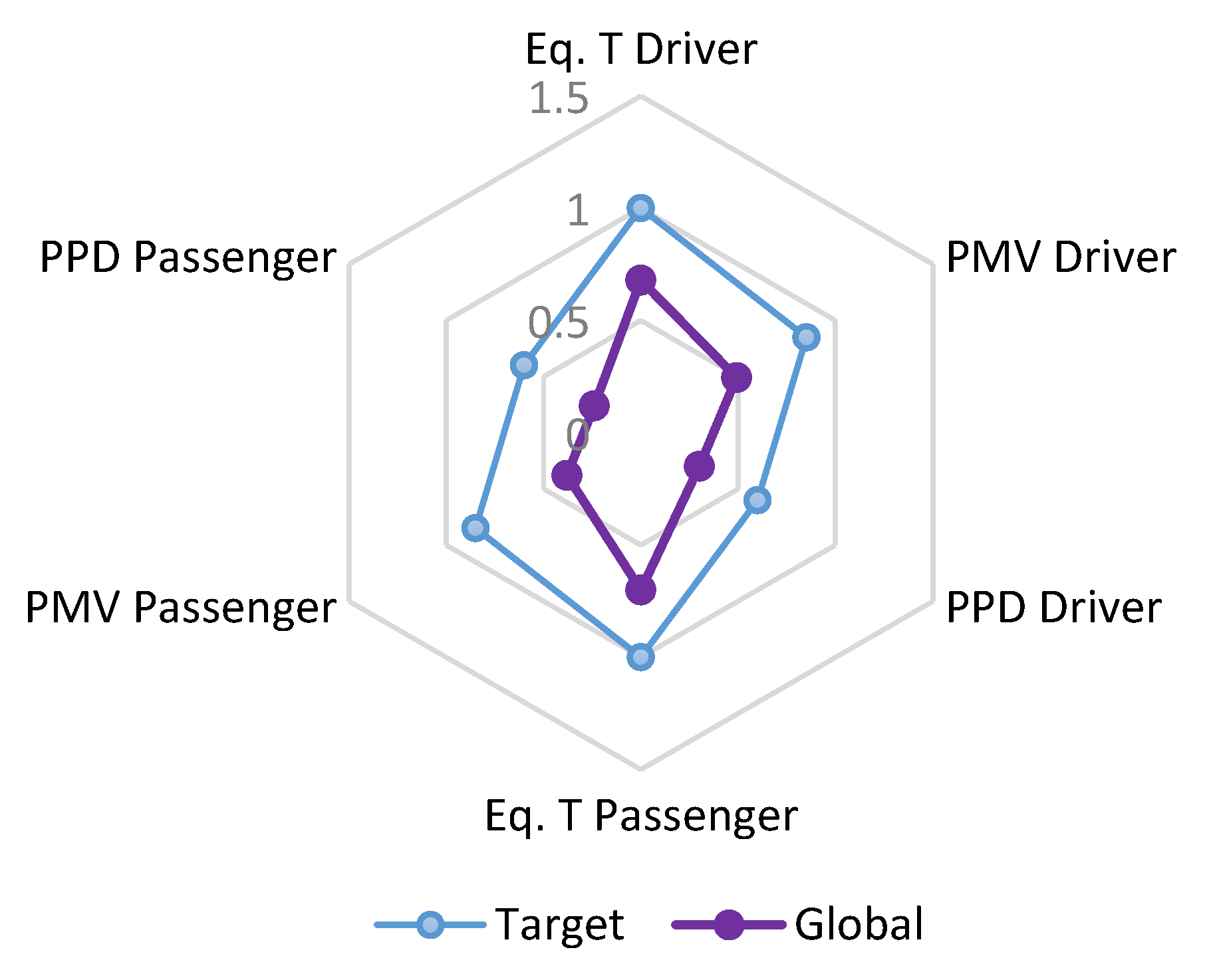
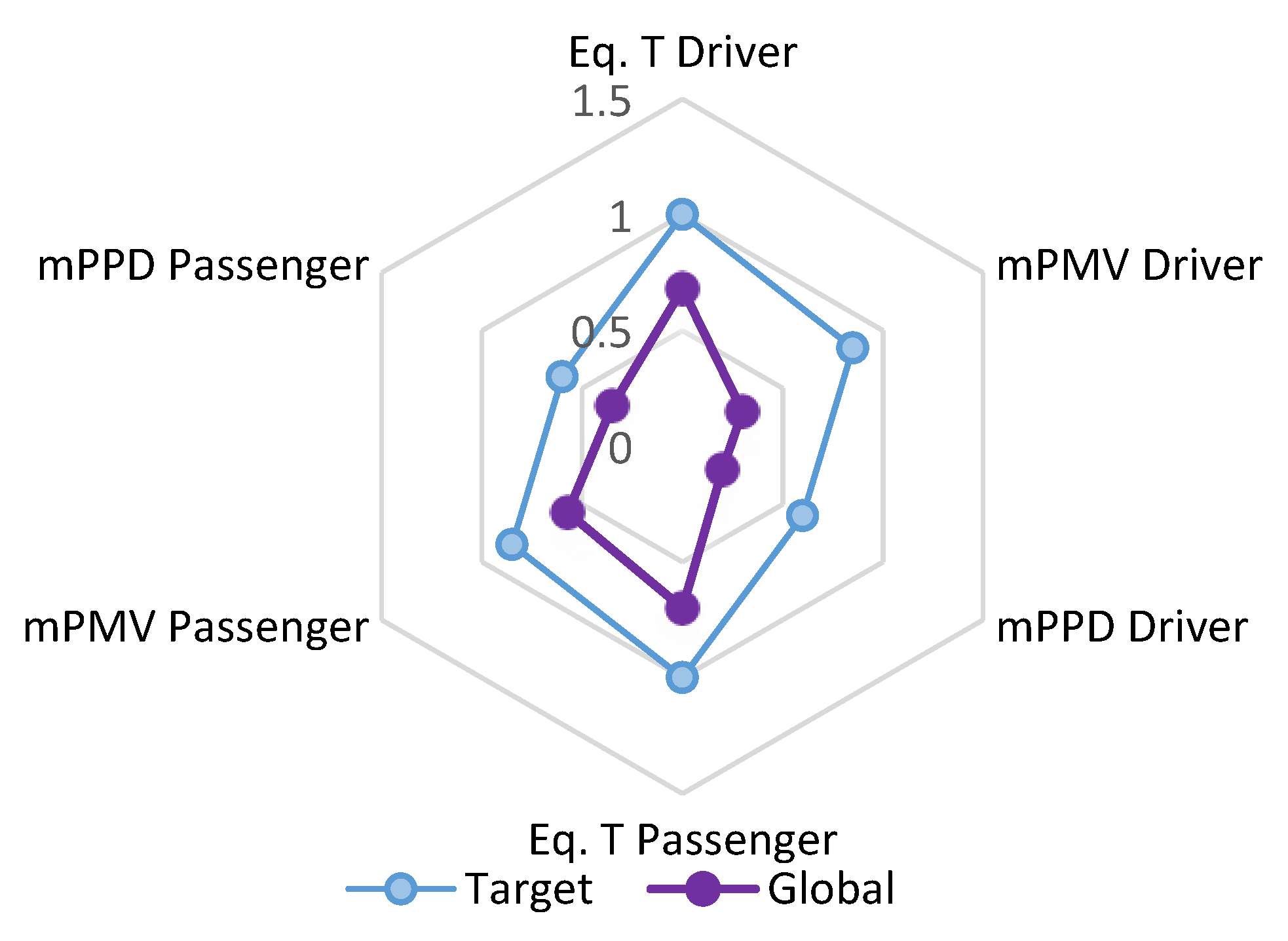
| Location | Longitude | Latitude | Time | Date | Solar Irradiation |
|---|---|---|---|---|---|
| Daegu, South Korea | 128°35′E | 35°52′N | 13:00 | 21 June 2018 | 875 W/m2 |
| Human Body | Wears | Seat | Windshield/Front and Rare Glass | |
|---|---|---|---|---|
| Material | Skin | Cotton | Polyurethane Foam | Glass |
| Thermal Conductivity (W/m2K) | 0.21 | 0.04 | 0.05 | 1.171 |
| Specific Heat (J/Kg-K) | 3770 | 1480.1 | 1685.60 | 2529.5 |
| Density (kg/m3) | 1000 | 1297.01 | 70 | 754 |
© 2020 by the authors. Licensee MDPI, Basel, Switzerland. This article is an open access article distributed under the terms and conditions of the Creative Commons Attribution (CC BY) license (http://creativecommons.org/licenses/by/4.0/).
Share and Cite
Khatoon, S.; Kim, M.-H. Thermal Comfort in the Passenger Compartment Using a 3-D Numerical Analysis and Comparison with Fanger’s Comfort Models. Energies 2020, 13, 690. https://doi.org/10.3390/en13030690
Khatoon S, Kim M-H. Thermal Comfort in the Passenger Compartment Using a 3-D Numerical Analysis and Comparison with Fanger’s Comfort Models. Energies. 2020; 13(3):690. https://doi.org/10.3390/en13030690
Chicago/Turabian StyleKhatoon, Saboora, and Man-Hoe Kim. 2020. "Thermal Comfort in the Passenger Compartment Using a 3-D Numerical Analysis and Comparison with Fanger’s Comfort Models" Energies 13, no. 3: 690. https://doi.org/10.3390/en13030690
APA StyleKhatoon, S., & Kim, M.-H. (2020). Thermal Comfort in the Passenger Compartment Using a 3-D Numerical Analysis and Comparison with Fanger’s Comfort Models. Energies, 13(3), 690. https://doi.org/10.3390/en13030690






